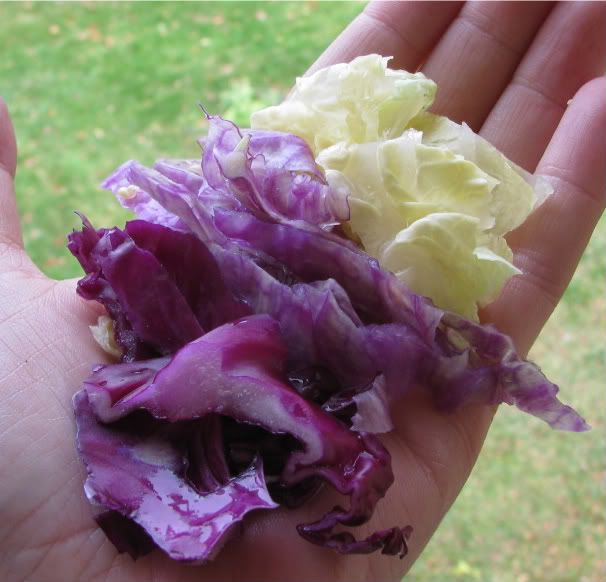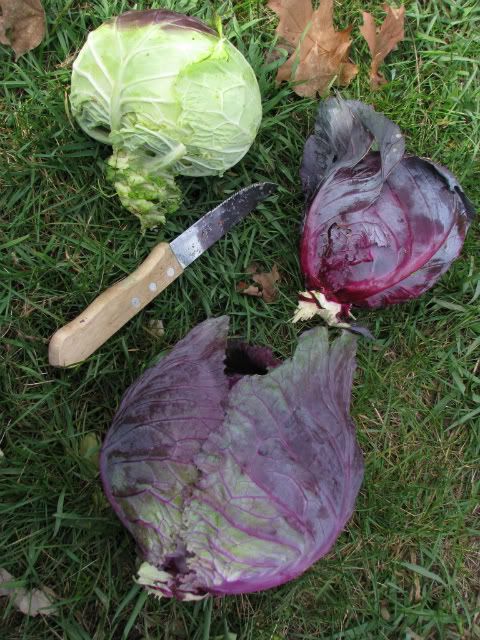|
|
Post by Joseph Lofthouse on Oct 28, 2011 11:28:37 GMT -5
I planted my seeds in an area with perennial rhizome grass roots that didn't get properly weeded, so some plants had competition and didn't grow well.... Germination was bad for me. It was also bad for the Kohlrabi planted on the same day, so I'm blaming the weather. This was extremely long season for me, getting harvested after we had been having a number of light fall frosts. The leaves in the head were tight, so even if the outside had gobs of bugs (aphids) the inside was great. Cabbage yellows and whites did not find it attractive.
Speaking of rhizome grass roots, I'm moving my early planting bed to a different part of the garden that is free of grass roots. Hoping that will give me an opportunity to get after the grass better.
|
|
|
|
Post by ottawagardener on Oct 28, 2011 16:28:08 GMT -5
Joseph: So did you direct seed the cabbage then? I tend to plant mine as starts. One year, I did try direct seeding Red Rock Mammoth but it under performed for me.
|
|
|
|
Post by Joseph Lofthouse on Oct 28, 2011 17:51:09 GMT -5
Yes, I direct seeded the cabbage. I don't have a proper easy to use greenhouse, so most everything gets direct seeded except for tomatoes and peppers.
|
|
|
|
Post by turtleheart on Oct 28, 2011 21:42:22 GMT -5
i want to be rid of that plastic tent for good. it is my main disease vector thing. i need to find a way to direct sow tomatoes that is seed efficient.
|
|
|
|
Post by Joseph Lofthouse on Oct 28, 2011 22:02:26 GMT -5
That's very doable... Direct sow your tomatoes... Direct sow hundreds of varieties, make open pollinated and deliberate crosses, and plant them and allow them to segregate. Save the seeds from anything that grows reasonably well. And then plant their offspring. Keep the best growing in their own group. Repeat year after year until you get a crop that can be reliably direct sown in your garden.
And don't turn your nose up at cherry tomatoes... So what if they are small, and hard to pick. They can be very productive and reliable under direct seeded growing conditions.
And you might can direct sow them 3 weeks before your average last frost date... If you do that every year, you will select for those strains that grow best in cooler spring weather.
Or do it the no effort way... Throw a rotting tomato onto a planting hill in the fall. (Is that what you call your planting places?) Don't disturb them the following spring and summer. Let them produce a crop for you. Repeat year after year, selecting for those individuals that grow best when planted in that manner.
|
|
|
|
Post by ottawagardener on Oct 29, 2011 7:24:54 GMT -5
How long is your season Turtleheart? I always get fruiting volunteers and so many seeds in the fruit that loss is not an issue. This year, I direct seeded sauce and drying tomatoes as an experiment as I'm not looking for 'super earliness' with those but just a bulk harvest. It worked like a charm. My season is about 120 days on average of frost free weather. You could also try winter sowing tomatoes.
Alan made a few references to a bunch of cherry tomatoes that he has in a semi-feral population on his farm.
|
|
|
|
Post by ottawagardener on Oct 29, 2011 12:40:16 GMT -5
And a few more pictures: Shredded cabbage from top to bottom: San Michele - Cross - Red Rock Mammoth. The inside of the cross more closely resembles the savoy to me though less crinkled with a lovely violet streaked leaves.  Here they are again: Green is San Michele, small purple is Red Rock and cross is on the bottom:  This cabbage which weighed 4lbs was being quite ambitious and produced a number of bite sized secondary heads in lower nodes. I wonder if the wrapper leaves were damaged so that it was inspired to produce more 'flower heads.' I noticed the same tendency on other crosses and the San Michele savoy. The Red rocks didn't show that. This was the best example though.  |
|
|
|
Post by steev on Oct 29, 2011 22:28:23 GMT -5
The inside of the cross is really very attractive, and appears less coarse than Red Rock. Very nice, altogether.
|
|
|
|
Post by 12540dumont on Oct 31, 2011 0:40:48 GMT -5
It's so beautiful, Leo is desperate for this cabbage. We grew the San Michele, and he believes it is beautiful. But yours is really purdy.
|
|
|
|
Post by oxbowfarm on Oct 31, 2011 5:32:25 GMT -5
Do you guys have the swede midge in Ottawa yet? Certainly those cabbages don't look like they've been hit. I also covet them.
|
|
|
|
Post by ottawagardener on Oct 31, 2011 13:21:14 GMT -5
I wish I had more seeds to pass around! I'm currently planning to overwinter the F1s and their parents in situ so we'll see what next year holds. The cross itself was easy enough if you want to try - San Michele as the pod parent surrounded by a group of Red Rocks - the bees did the work. Hopefully some of the others I sent seed to will also try and overwinter.
I thought I found some swede midge damage once in a brassica in the city but haven't seen it since so I'm hoping I was wrong. When I heard about that pest, I almost decided to just grow kale, mustard, arugula and other sure fires as cabbages, broccoli and their ilk can be such sissies when it comes to pest, disease and environmental pressure.
|
|
|
|
Post by extremegardener on Nov 3, 2011 12:19:08 GMT -5
This cabbage which weighed 4lbs was being quite ambitious and produced a number of bite sized secondary heads in lower nodes. I wonder if the wrapper leaves were damaged so that it was inspired to produce more 'flower heads.' I noticed the same tendency on other crosses and the San Michele savoy. The Red rocks didn't show that. This was the best example though. I just checked underneath the big uncut heads still out in the garden, and found some secondary heads underneath also. The one I cut in early September did this:  which confirms that this cross likes to sprout secondaries - I haven't ever observed that much vigor in making secondaries in other cabbages, except maybe Offenham. So, I'm excited, cause it looks like it just might overwinter, and I got to eat the very large head as well. I still have a bunch of mostly very very large cabbages out there. I will definitely experiment with leaving a couple with heads intact to overwinter, but with some, I'm going to cut the heads I harvest with care (as I did with the first one) and hope that they will overwinter, too. Do you usually throw some mulch on the Mammoth Red Rocks that you've overwintered? I hesitate because of the rodents... |
|
|
|
Post by ottawagardener on Nov 3, 2011 15:13:04 GMT -5
Not normally no. Good point about the rodents - we have our fair share of those. I generally just put some leaves around the ground, near the roots.
|
|
|
|
Post by steev on Nov 3, 2011 18:36:00 GMT -5
Seems a good veggie to harvest the main head and leave the secondaries for seed, very handy.
If rodents are an overwintering problem, and you want not to pot up plants into storage, could you put down wire mesh and a basket of wire over, before mulching to protect?
|
|
|
|
Post by extremegardener on Nov 4, 2011 10:30:59 GMT -5
Seems a good veggie to harvest the main head and leave the secondaries for seed, very handy. If rodents are an overwintering problem, and you want not to pot up plants into storage, could you put down wire mesh and a basket of wire over, before mulching to protect? I wish... and I have done that to protect from deer. Unfortunately the voles are underground. They use tunnels dug by moles, and eat entire plants, roots and all... I hate voles... I have seen them pull small chicory plants down into the ground and devour them. |
|